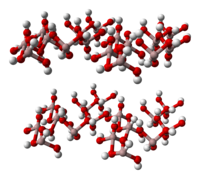
Photo from wikipedia
Abstract Crystallization inside the liquid slag of entrained flow gasifiers can increase the viscosity of the slag, affecting flow down the wall and resulting in operational problems. The chemical component… Click to show full abstract
Abstract Crystallization inside the liquid slag of entrained flow gasifiers can increase the viscosity of the slag, affecting flow down the wall and resulting in operational problems. The chemical component of the slag is an intrinsic factor of crystallization characteristics. In the study presented here, Differential Scanning Calorimetry (DSC) and the Single Hot Thermocouple Technique (SHTT) were combined to investigate the influence of (SiO 2 + Al 2 O 3 ) ratios on crystallization temperature and crystalline morphology, and to construct temperature-time transformation (TTT) diagrams. Five synthetic slags with different amounts of silica and alumina (silica/alumina keeps constant) were prepared for their crystallization tendency. The mass ratio of (SiO 2 + Al 2 O 3 ) ranges from 30 to 70 wt.%. For the kinetics calculation, the Kissinger method was applied for activation energy under cooling conditions with DSC results and the JMA equation was used for crystallization mechanisms based on SHTT results under isothermal conditions. Bulk quenching samples were produced in a high temperature quenching furnace and analyzed by XRD to determine phases. The thermodynamic modeling program FactSage was also applied to predict the equilibrium composition and compared with experimental results. It turns out that crystallization of the slag with high amount of (SiO 2 + Al 2 O 3 ) was so weak that the crystals could hardly be observed. Higher basic oxides favored crystallization and led to higher crystallization temperature. When the proportion of (SiO 2 + Al 2 O 3 ) reduced to 30%, the crystallization tendency was extremely strong that the crystals formed at 1380 °C.
Journal Title: Fuel
Year Published: 2017
Link to full text (if available)
Share on Social Media: Sign Up to like & get
recommendations!